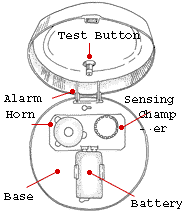Home > House Structure > Smoke detectors
Smoke detectors
Smoke detectors, also known as smoke alarms, are critical devices installed in houses to detect the presence of smoke and alert occupants of a potential fire. They play a vital role in ensuring the safety of residents by providing early warning and allowing them to evacuate or respond to a fire emergency promptly. Here are some key aspects of smoke detectors in houses:
Function:
Smoke detectors are designed to detect smoke particles in the air. They consist of sensors that can sense the presence of smoke or combustion byproducts, such as carbon monoxide. When smoke particles are detected, the detector emits a loud alarm sound, typically a high-pitched siren, to alert the occupants.
Types of Smoke Detectors:
I. Ionization Smoke Detectors: These detectors contain a small amount of radioactive material that ionizes the air inside the detector. When smoke enters the ionization chamber, it disrupts the ion flow, triggering the alarm.
II. Photoelectric Smoke Detectors: Photoelectric detectors use a beam of light inside the unit. When smoke particles enter the chamber, they scatter the light, causing it to be detected by a sensor, which then triggers the alarm.
III. Dual Sensor Smoke Detectors: These detectors combine both ionization and photoelectric technologies to provide enhanced smoke detection capabilities. They are designed to detect a wider range of fires, including fast-flaming and smoldering fires.
Placement and Installation:
To ensure optimal performance, smoke detectors should be strategically placed throughout the house. Key locations include:
• Bedrooms: Install smoke detectors in each bedroom or outside sleeping areas to provide early warning in case of a fire at night.
• Hallways: Place detectors in hallways leading to bedrooms to detect smoke that may be present before it reaches the sleeping areas.
• Living Areas: Install detectors in common areas such as living rooms, dining rooms, and family rooms to cover the main living spaces of the house.
• Kitchen: Due to the potential for false alarms from cooking activities, it is recommended to install a heat detector or a combination smoke/heat detector in the kitchen instead of a regular smoke detector.
• Maintenance and Testing: Regular maintenance of smoke detectors is crucial to ensure their effectiveness. Here are some maintenance tips:
• Test the detectors regularly: Press the test button on the detector to check if the alarm sounds. It is recommended to test them at least once a month.
• Replace batteries: Smoke detectors often use replaceable batteries. Replace the batteries at least once a year or as recommended by the manufacturer.
• Clean the detectors: Dust or debris can hinder the detector's performance. Gently vacuum or clean the detector using a soft brush to remove any accumulated dirt.
• Replace old detectors: Smoke detectors have a limited lifespan, typically around 10 years. Replace older detectors to ensure their reliability.
• Benefits: Smoke detectors offer several benefits in house safety:
• Early detection: Smoke detectors provide early warning, allowing occupants to respond quickly and evacuate the premises in the event of a fire.
• Life-saving potential: Timely detection of smoke and fire can significantly reduce the risk of injuries or fatalities by providing precious minutes to escape or take appropriate action.
• Property protection: Early detection can help minimize property damage by allowing faster response from emergency services.
• Peace of mind: Having functional smoke detectors in the house provides peace of mind, knowing that there is an added layer of protection against fire-related hazards.
Smoke detectors are an essential safety feature in every house. Their proper placement, regular testing, and maintenance are crucial for ensuring their effectiveness. By detecting smoke early, they provide invaluable time for residents to evacuate and respond to a fire emergency, potentially saving lives and minimizing property damage.










